From which factors does the hair quality depend on?
Hair quality is genetically predetermined, but it also depends on external factors. The thickness and quality of the hair depends on the racial origin. For example, Asians have thicker and more durable hair than other races, while people of European descent have thinner hair and less hair in relation with all racial groups. Women also have half of the hair diameter compared to men, while the hair thickness varies depending on age, too. At younger ages, the hair is thicker and more resistant while it becomes less dense and much thinner with aging.
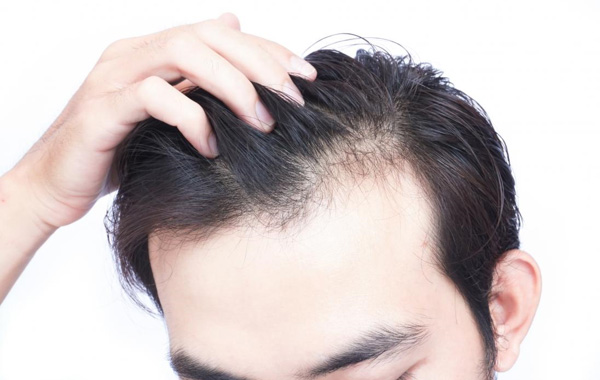
Hair life cycle
The normal hair loss is 50-80 hairs per day while most of them go away after shampooing. These are replaced by others, as each hair goes through 3 phases during its life which is about 2-7 years. The 1st phase is the anagen that lasts the longest period (years), the 2nd phase is the catagen that lasts 3 weeks and the last one is the telogen that lasts 3 months and in the meantime the hair falls. Under normal circumstances, most of the hair (about 90%) is in the anagen phase (growing phase). The change of the analogy of these phases can be checked with a trichorizogram, i.e. to determine if the hair loss is normal e.g. due to seasonality or there is a pathological cause.
Factors and causes that lead to hair loss
At times, we may notice greater hair loss than normal, which is usually rebuilt within a few months and is associated with stressful periods of life (surgical stress, anxiety, depression, etc.). Also, the environment and the diet can play an important role in hair loss, while the toxic metals that are widely used in industry as well as the foods may create toxicity and hair loss.
The most common causes of hair loss are in addition to stress, seasonality, thyroid dysfunction, iron deficiency, puerperium (period following childbirth) and discontinuation of contraceptives, the intake of certain medications (retinoids, barbiturates, chemotherapy drugs), exhausting weight loss diets and of course the most common factor, the heredity.
In addition to the history and clinical examination, the dermatologist also performs trichoscopy (a type of “dermoscopy” of the scalp) with the dermatoscope to diagnose and exclude various hair diseases. There are diseases of the scalp that lead to permanent alopecia (such as Follicular Lichen Planus (FLP), Discoid Lupus Erythematosus (DLE), etc.) that must be diagnosed early in order not to permanently lose the hair of the affected area. Also infections, mainly fungal ones, can lead to thinning in the affected area. Also, the alopecia areata (or spot baldness) is a very common disease and can occur in children, too.
Trichotillomania (or hair-pulling disorder) is another condition, more common in children and has a characteristic clinical demonstration even if the patient does not confess to the habit of pulling hair.
But the majority of the cases have increased hair loss without other symptoms and the dermatologist has to find out the cause and provide the appropriate treatment.
Blood Tests
The suggested blood tests are general blood test, for iron and ferritin deficiency, thyroid hormone test, for zinc deficiency as well as some subtests where are needed. In many cases, the heredity, even if the parents do not have alopecia, is a major cause of hair loss.
There is also the TrichoTest that is a genetic test which analyzes specific genes that are responsible for hair loss. It is performed by the dermatologist by taking saliva with a swab from the patient’s mouth. The results show a specific etiopathology and thus the patient is led to receive a targeted and individualized treatment for his/her problem.
Treatment
In most cases, diffuse alopecia (hair loss) that is not related to organic causes is restored with the help of special topical preparations that regenerate the hair and extend its life while they reduce the micro-inflammation around the hair follicle. Also, dietary supplements containing cysteine, zinc and B-Complex vitamins are also given for a limited and specific period of time. When the relevant test is performed, the treatment is more accurate and with better results. There are also ancillary products (such as shampoos, ampoules, lotions) that complete the treatment. Hair dyes, hairdressing and styling products do not affect hair loss, but the quality of the hair that can be damaged by their excessive use. Likewise, the use of a helmet and the frequent shampooing do not cause hair thinning.
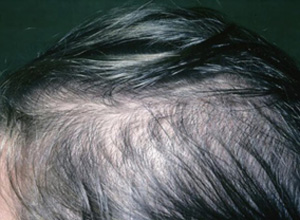 ανδρογεννητικού τύπου αλωπεκία
ανδρογεννητικού τύπου αλωπεκία
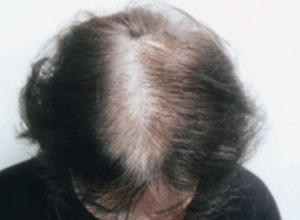 ανδρογεννητικού τύπου αλωπεκία σε γυναίκα
ανδρογεννητικού τύπου αλωπεκία σε γυναίκα
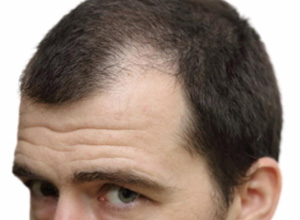 ανδρογεννητικού τύπου αλωπεκία
ανδρογεννητικού τύπου αλωπεκία
Androgenetic alopecia (AGA) also known as male pattern baldness is a genetic predisposition to hair loss that affects the largest percentage of men. It is due to genetic causes that make the androgen receptors in the hair follicles sensitive to normal androgens. The result is that the hair becomes weaker gradually (fluffy), then thins and eventually falls out. There are different patterns of androgenetic alopecia in men. So, some men lose hair in the frontal area, others from the center of the head and some others from the temporal area. However, the hair growth is always maintained in the occipital region (back of the head) and from there transplants are taken in cases where hair transplantation is performed.
The treatment is applied with topical preparations containing minoxidil, a drug that was initially used as an antihypertensive medication and had a serious side effect of hypertrichosis. Then, it was prepared for topical use and has very good results in androgenetic alopecia with continuous use. It acts by increasing vascularity and consequently the nutrition of the hair follicle. The dosage regimen includes 6 sprays twice a day for long or indefinite period of time. We can find it in the form of lotion and foam while the dermatologist can add other substances in combination.
Another suggestion for the treatment of androgenetic alopecia is the oral administration of finasteride (a 5-alpha reductase inhibitor) which acts by blocking an enzyme that converts testosterone into a form that can enter into cells. So, it does not affect testosterone levels in the body. This medicine can be administered safely for up to 5 years and can be combined with the treatment with minoxidil.
The type of androgenetic alopecia in women differs from the androgenetic alopecia in men. Even, in serious cases women do not lose the hair from the frontal temporal line. The androgenetic alopecia in women is aggravated after menopause. This happens because the levels of estrogen are decreased and the androgens predominate. Younger women who have androgenetic alopecia heredity and demonstrate high androgen levels may also lose hair. Minoxidil can also help significantly in androgenetic alopecia in women, while a topical solution containing estradiol can be administered to postmenopausal women.
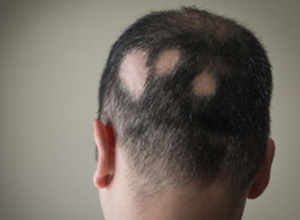 γυροειδης αλωπεκία
γυροειδης αλωπεκία
There are also alopecias such as alopecia areata where hair is lost from specific areas of the scalp leaving oval or round bald patches. More than 80% of the patients have spontaneous hair re-growth while the treatment includes cortisone lotions or cortisone injections on the lesions in order to stop alopecia areata from spreading. When the hair starts to regrow, it may grow in white or blond in color, and finer than before. This is usually temporary. With time, your natural hair color and texture often return. But, also some hairy areas such as beard, eyebrows or eyelashes may be affected. Thyroid function test and dental check are recommended as an inflammation in the teeth can cause the disease. The thyroid is checked for possible coexistence of autoimmune thyroiditis. Alopecia areata is usually self-limiting while etiologically it may be related to stress. Rarely and only in severe cases, the oral treatment with cortisone or immunosuppressive therapy (e.g. cyclosporine) is needed.
Treatment with Platelet-Rich Plasma (PRP) (autologous) and Mesotherapy with minoxidil
When we would like to have an immediate result in the case of androgenetic alopecia, alopecia areata or diffuse alopecia areata in addition to the daily treatment, we apply mesotherapy every month, i.e. injections into the scalp, that it may be autologous with the patient’s own blood containing substances that regrow the hair or by injections of minoxidil. The results are individualized, but in cases where local treatment is not enough, it is worth choosing. 6 treatments are required (1 per month) and follow up treatment every 3 months.
Finally, some dermatological diseases leave permanent alopecia, i.e. hair does not reappear in the affected areas (e.g. Follicular Lichen Planus (FLP), Discoid Lupus Erythematosus (DLE)) and early diagnosis and treatment is very important to stop the progression of the disease.